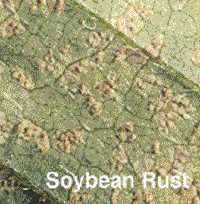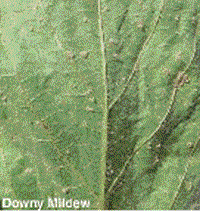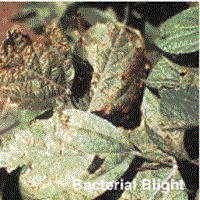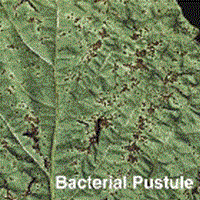Characteristics of Soybean Foliar Diseases from Bacterial Blight to Rust
 |
Dean MalvickAssistant Professor of Plant Pathology and Extension SpecialistPhone: (217) 265-5166 E-mail: dmalvick@illinois.edu |
||
Introduction
Although root and stem diseases have generally been the most important diseases of soybean in Illinois (Table 1), much concern has been raised recently about foliar diseases, especially soybean rust. In this context, foliar diseases are considered those that primarily infect and damage soybean leaves. They do not include diseases that infect the roots and stems and have secondary effects on leaves, such as BSR, SDS, and white mold. Although viruses can also cause important foliar diseases, this presentation will focus on fungal and bacterial diseases.
Foliar diseases are getting increased attention for several reasons. Foremost, is the concern about soybean rust, which has the potential to cause considerable yield loss. Second, weather conditions were quite favorable in Illinois for many foliar diseases during the 2004 growing season. These included Septoria brown spot, downy mildew, bacterial blight, Cercospora leaf blight, and frogeye leaf spot. Many questions have arisen regarding the diagnosis, potential for yield losses, and management of these foliar diseases. A third reason is that fungicide spray programs are being increasingly used, sometimes with mixed results, and discussed for soybeans. However, the actual effects of the fungicides on foliar diseases are generally poorly understood.
With the increased awareness of soybean rust, many soybean fields have been getting (and will get) increased attention. Most foliar diseases are fairly easy to see compared to many other diseases and have been noted frequently. The exception to this is soybean rust, which is very difficult to see and detect during early stages of infection and disease development. Furthermore, as efforts are made to increase soybean yields, foliar diseases and other factors are being considered as possible yield reducing problems that can potentially be managed to increase yields.
These factors have combined to increase interest and awareness of soybean foliar diseases and the need for increased understanding of diagnosis, biology, damage potential, and disease management. This presentation will cover diagnosis and characteristics of soybean rust as well as common soybean foliar diseases, and will discuss potential relative yield losses due to these diseases. Yield losses due foliar diseases are highly variable from year to year and location to location depending in a large part on environment. This information will not only be beneficial in understanding and diagnosing common foliar diseases, but will help in recognizing and managing soybean rust if and when this disease arrives in Illinois.
Descriptions, Characteristics, and Distinguishing Features of Foliar Soybean Rust and Common Foliar Diseases of Soybean
The following are examples of leaf diseases that are common in Illinois and which may be confused with soybean rust. Other diseases of soybean leaves and stems that are important and could potentially be partially controlled by foliar fungicide applications include frogeye leaf spot, pod and stem blight, and stem canker. Yield loss potential is indicated, with the caveat that yield loss estimates are very difficult to achieve with accuracy and the high estimates are generally extreme situations that are uncommon. Different varieties and cropping systems clearly can influence yield losses.
 |
Asian Soybean Rust��������������������������������������������� Caused by the fungus Phakopsora pachyrhizi.
|
 |
Septoria brown spot��������������������������������������������� Caused by the fungus Septoria glycines.
|
 |
Downy mildew��������������������������������������������� Caused by the fungal–like pathogen Peronospora manshurica.
|
 |
Bacterial blight��������������������������������������������� Caused by the bacterium Pseudomonas syringae pv. glycinea.
|
 |
Bacterial Pustule��������������������������������������������� Caused by the bacterium Xanthomonas campestris pv. glycines.
|
 |
Cercospora leaf blight��������������������������������������������� Caused by the fungus Cercospora kikuchii.
|
Scouting and Diagnosis
It may be wise to increase scouting for foliar diseases to determine what is affecting different soybean fields. This is especially important after the report of soybean rust in the southern continental U.S.A. Look high on the plants and look low, and include the upper and lower sides of leaves in your observations. Start scouting early in the season because some foliar diseases, including Septoria leaf spot and soybean rust, can occur as early as the seedling stages of crop development.
Diagnosis of foliar diseases can be a challenge, but look for the symptoms that are described above and use a good guide with additional descriptive information and clear color photographs. For thorough diagnosis, send samples to the University of Illinois Plant Clinic in Urbana. With the exception of soybean rust, these diseases can be seen in many circumstances with the naked eye. A hand lens of 10–20× will be critical for detection of soybean rust, especially in the early stages of infection. In many cases the foliar diseases of soybean may not be significant, but they may be significant under some situations and we should monitor when and where severe situations occur.
Tables & Figures
 |
| Table 1. Six most yield–reducing diseases of soybean in the top five soybean–producing countries in 1998 (estimated). Even before the introduction of Asian soybean rust to South America, foliar diseases were considered major problems in some countries. |